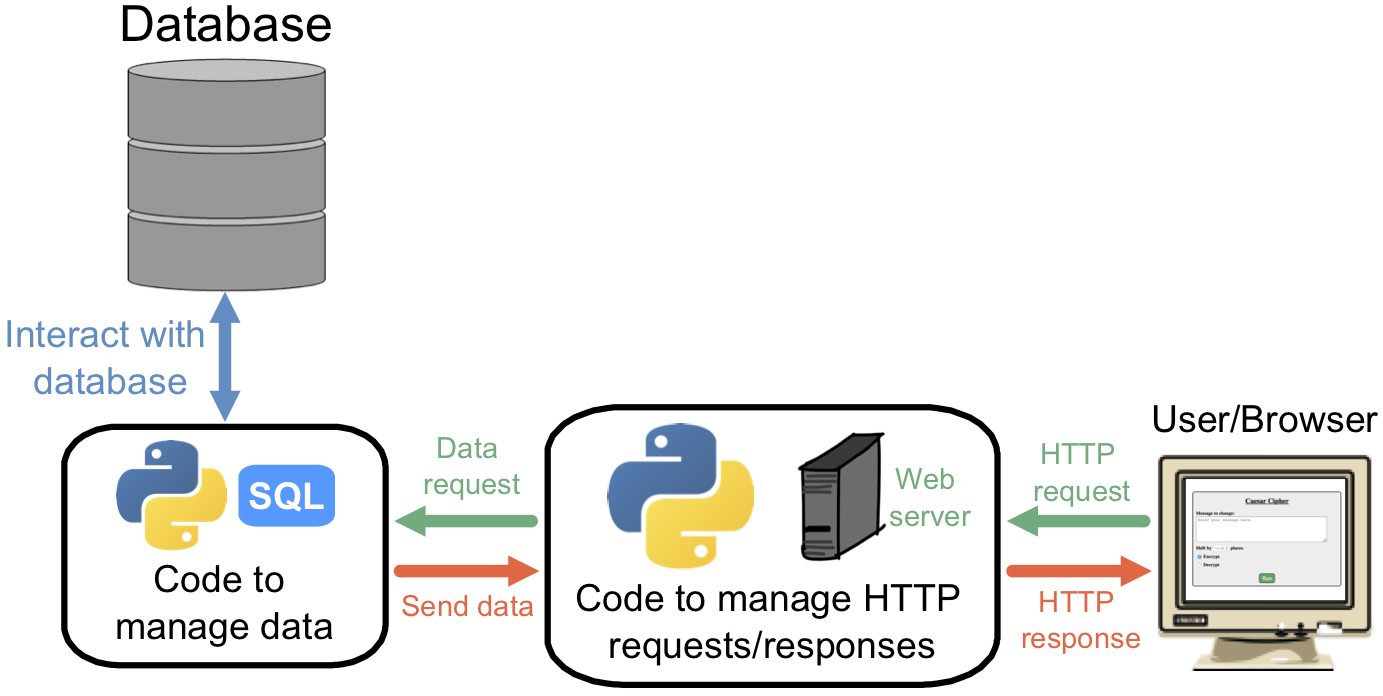24.1. What are Databases?¶
In the previous chapter, we learned how to use sessions to store data on a user’s device. This allows us to make the information persist after refreshing a web page or stopping and restarting our Flask app. However, the data is still temporary. It will be lost when the user quits their browser or clears their cookies.
In this chapter, we will learn how to store data in a more permanent way. We will also keep the data off of users’ machines, which gives us greater control over the information.
A database stores information and organizes it in a specific way. Unlike cookies, which contain a single key/value pair, databases allow us to manage a huge amount of content. Think of a database like a large hard drive. However, its only job is to store information. It runs no programs.
Using a database instead of sessions lets developers decide what information to save, who can access it, and how long to keep it.
24.1.1. Adding a Database¶
Databases remain separate from both the web server and a user’s computer. The diagram below shows how a database fits in with the server and a browser.
The figure splits the task of running a website into three large pieces. Let’s take a look at the different sections.
A user launches their browser and navigates to a website. They send HTTP requests to the web server, and their browser displays the responses on the screen. The user can only interact with the server.
The database only interacts with a special program built to manage data. The code accesses the database and creates new entries, reads information, updates exiting data, or deletes content that is no longer needed. The program does NOT communicate directly with visitors to the website.
A control program sits in between. It receives HTTP requests and sends back the responses. The code manages the web server, makes decisions, sends data to the browser, and interacts with the data management program. The control provides a useful middle step. It analyzes HTTP requests and filters out anything that might corrupt the database or access it without permission.
In the Flask applications we’ve built so far, main.py serves as the
control.
Warning
News stories pop up frequently about hackers stealing information or companies accidentally posting their customers’ data online.
When you attach a database to your web application, you MUST take steps to protect the information. Visitors to your website should never have direct access to where you store sensitive data.
An exploration of database security is beyond the scope of this course. Fortunately, you have access to the web. Feel free to study this topic on your own!
24.1.2. Communicating With a Database¶
To maintain consistency across the world, many companies use the same basic structure when they set up their databases. To interact with this structure, programmers use a tool called SQL, which stands for Structured Query Language.
Fun Fact
Are you a Marvel or DC person? How about Hufflepuff vs. Ravenclaw?
People pronounce SQL one of two ways, either like the word “sequel” or
by sounding out each letter, “ess-que-ell”. Both ways are acceptable, but
some programmers hold strong opinions about which one to use. Here’s a handy
cheat sheet to keep you out of trouble:
Pronounced “SQL”: Yep! 🙂
Pronounced “SQL”: Nope! 😡
Really, it doesn’t matter! 😉
Learning how to use SQL is a complete course by itself. Fortunately, Python provides us with some shortcuts. We will import the necessary module and explore how to use it later in this chapter.
For those who are interested in a good SQL tutorial, W3Schools provides one.
24.1.3. Check Your Understanding¶
Question
Visitors to a website interact with which of the following? Select ALL that apply.
- The web server
- The control program
- The data management program
- The database
Question
How long does information remain on a database?
- Until the user quits their browser.
- Until the user clears their sessions/cookies.
- For 24 hours.
- Until the developer decides to delete it.

